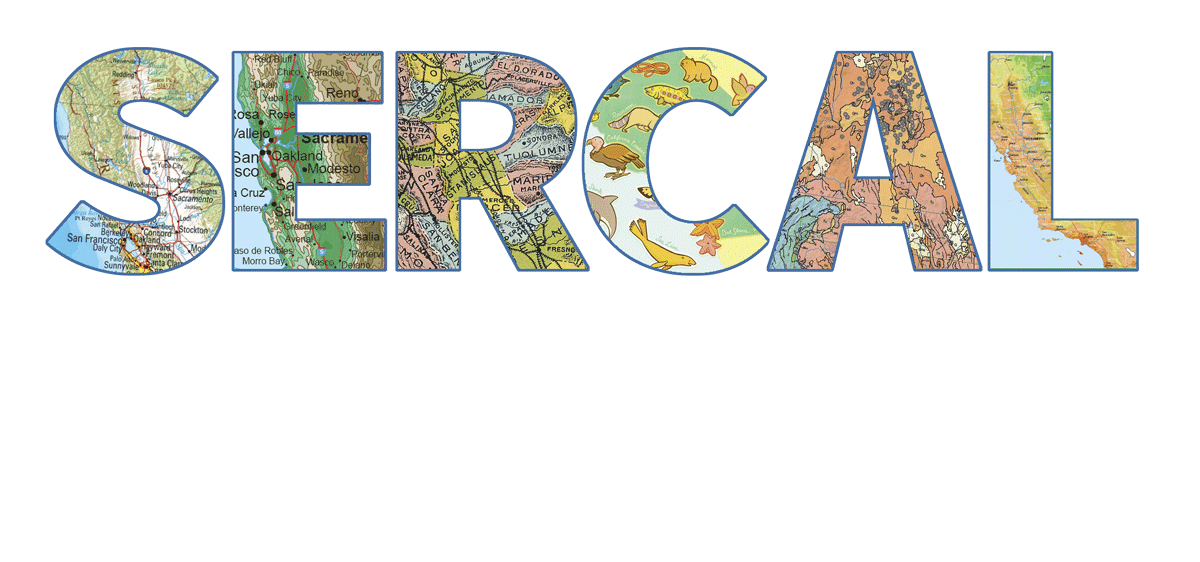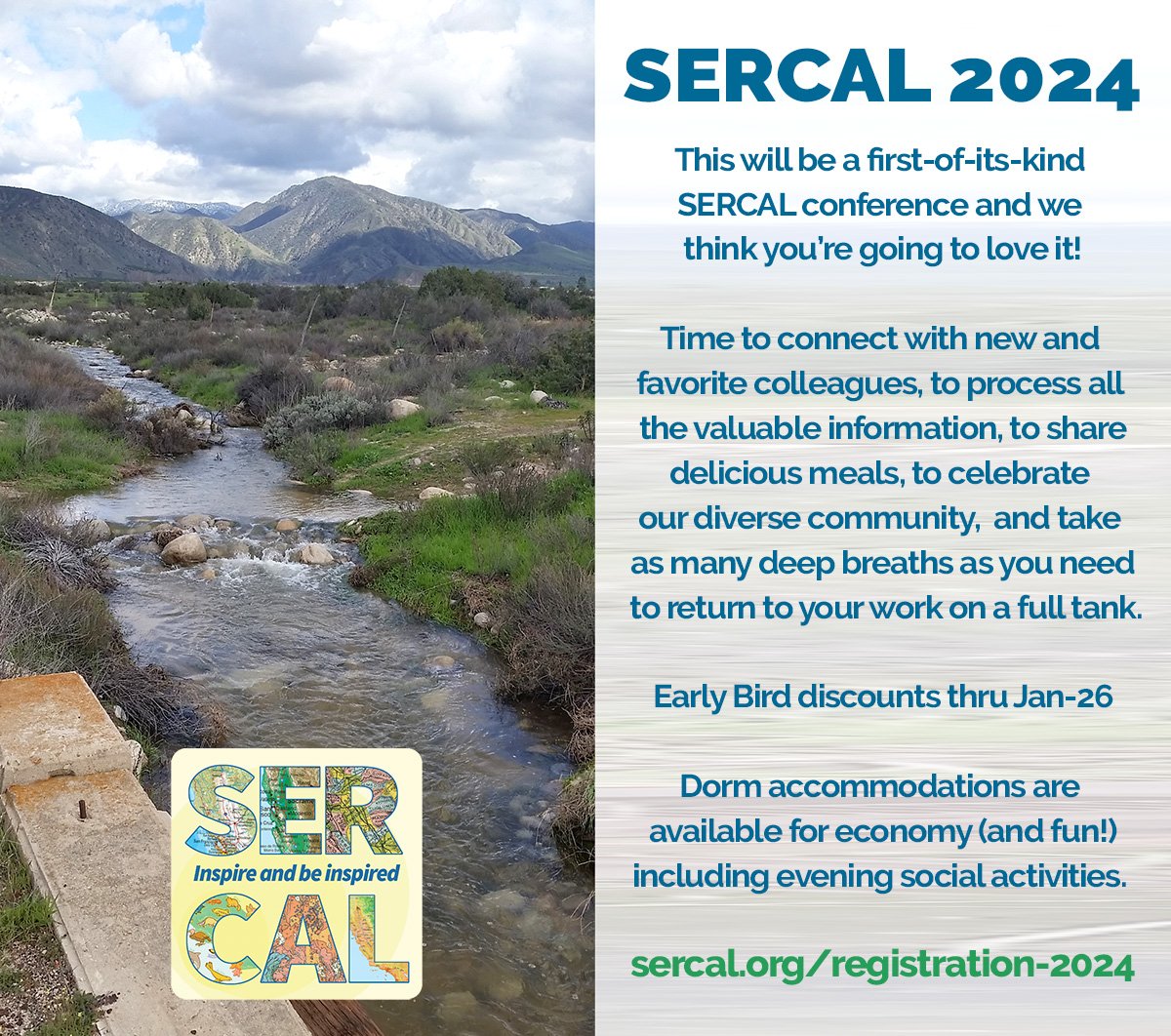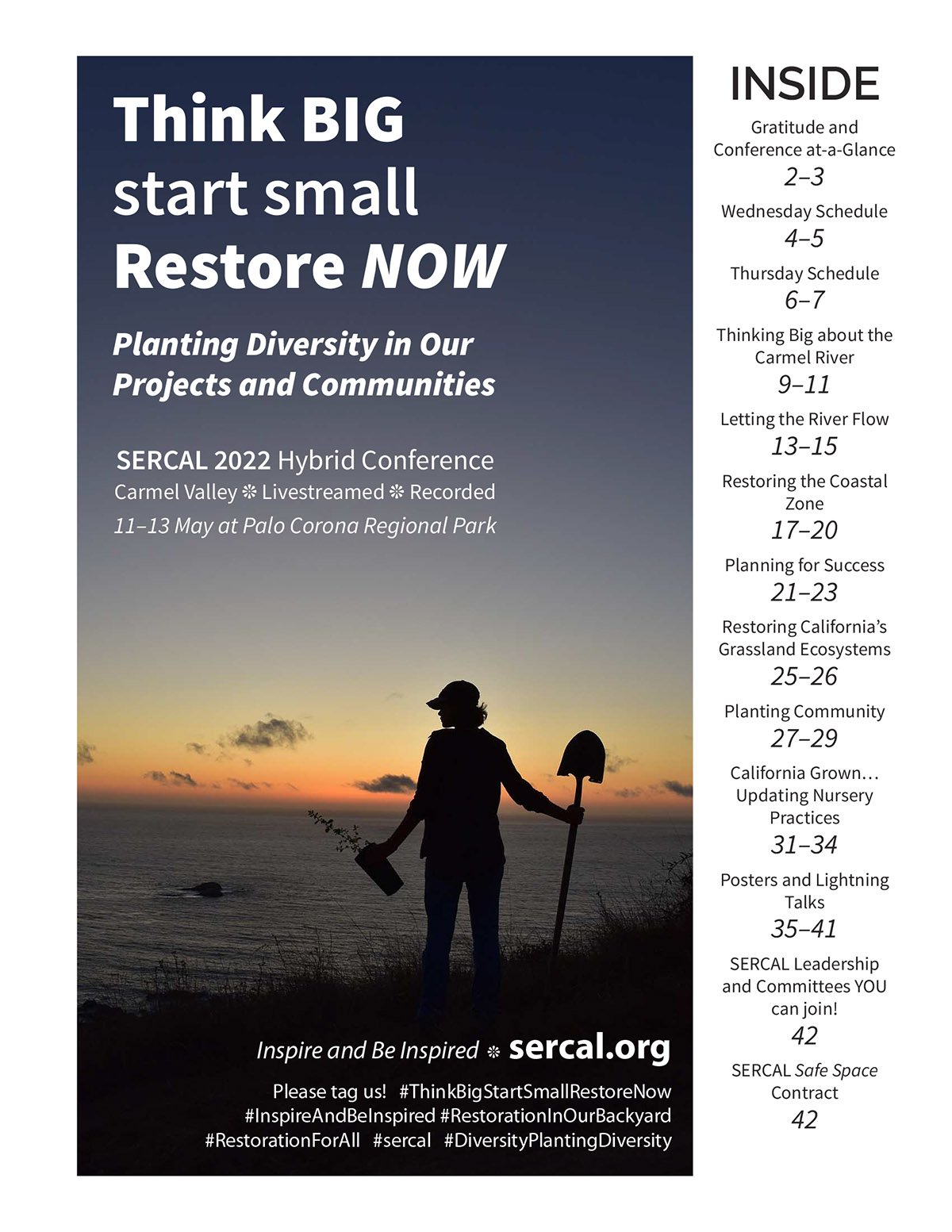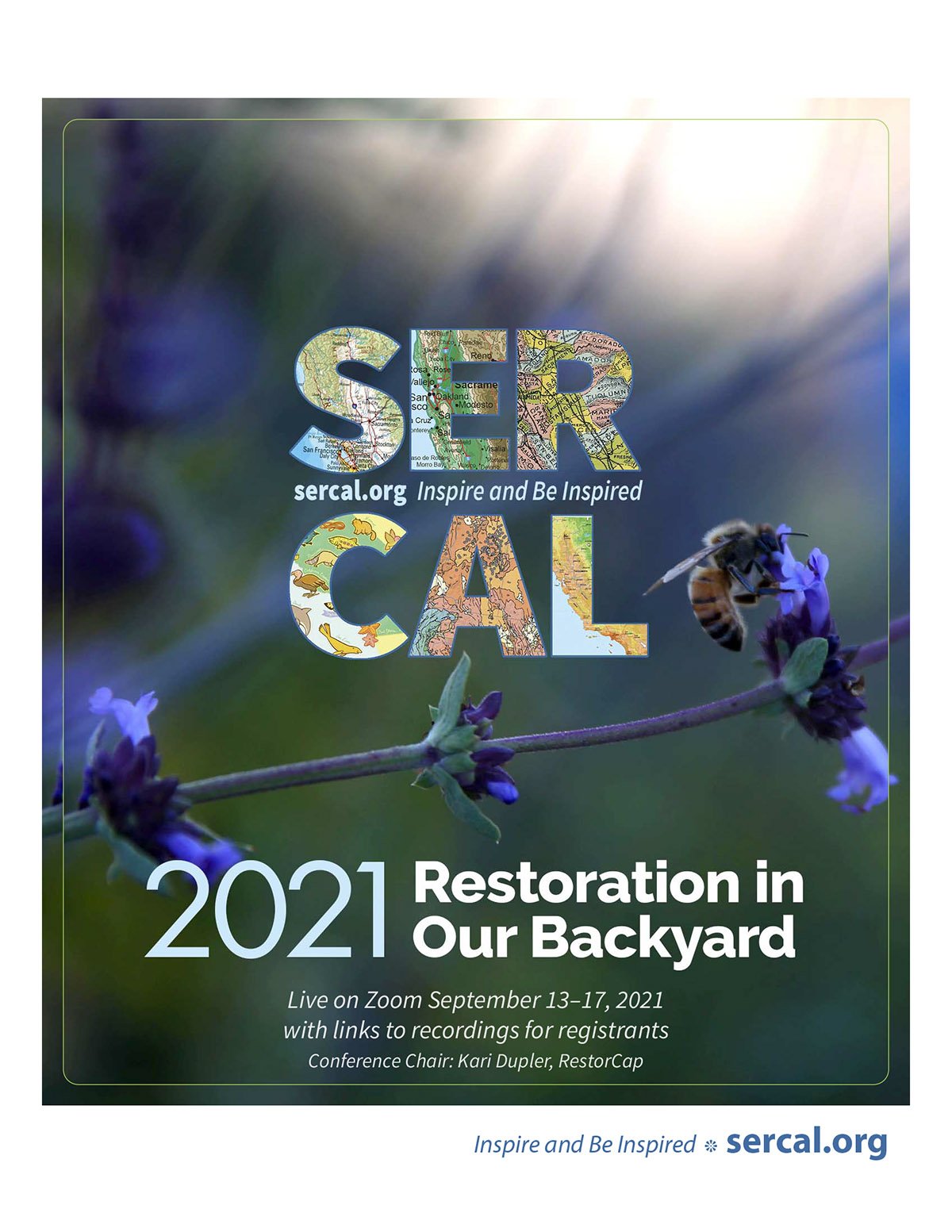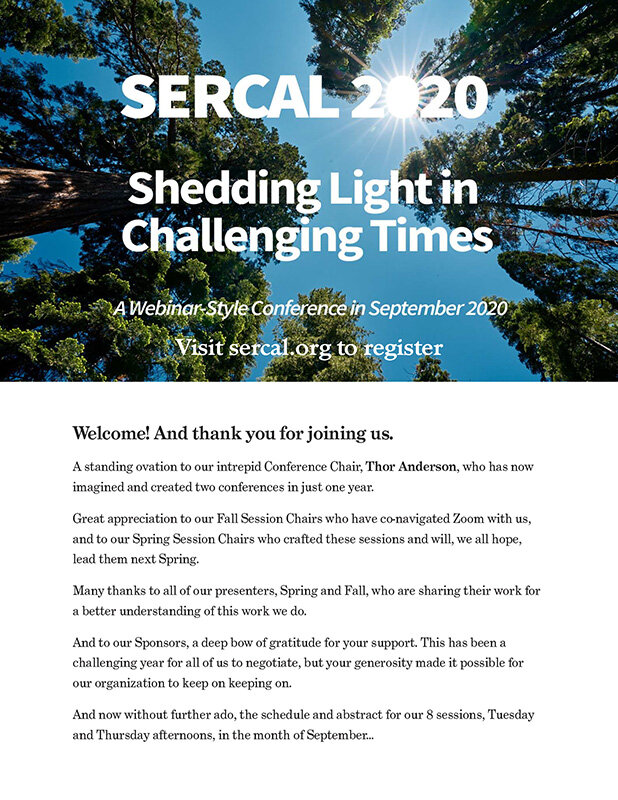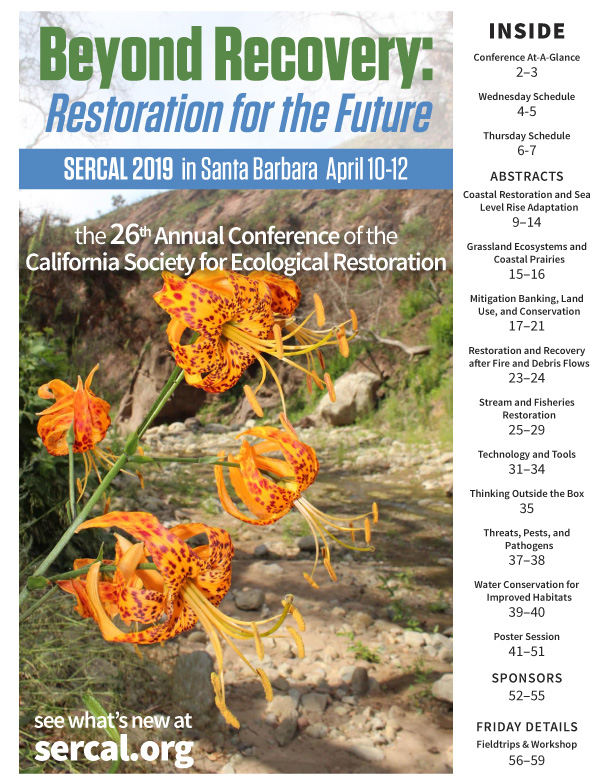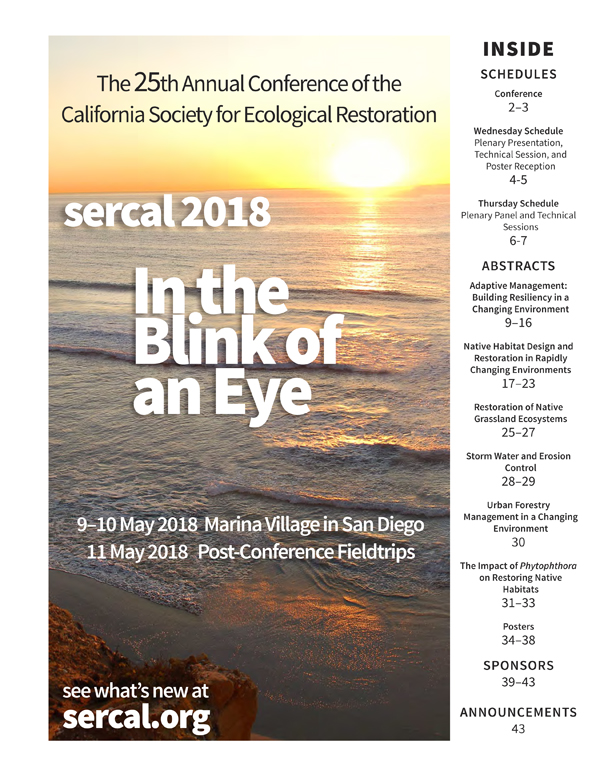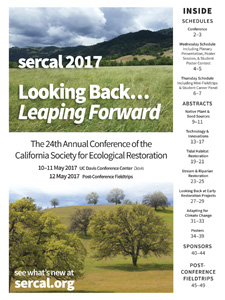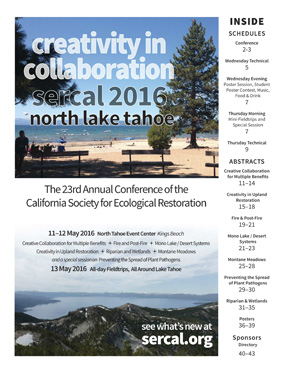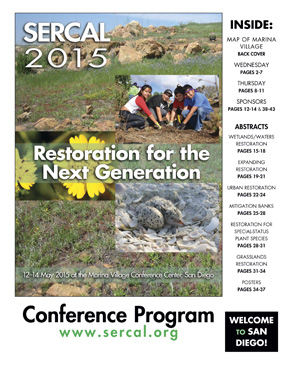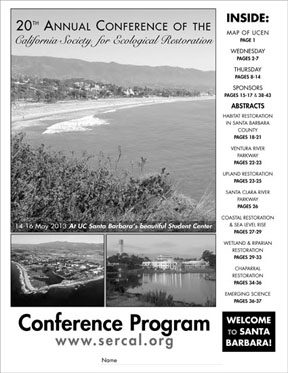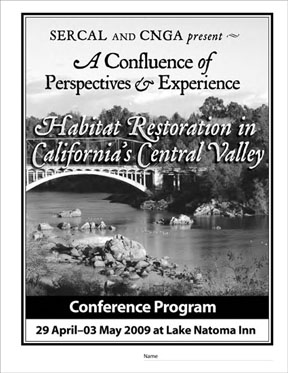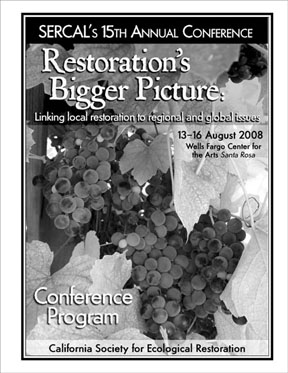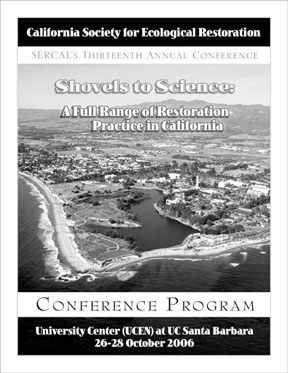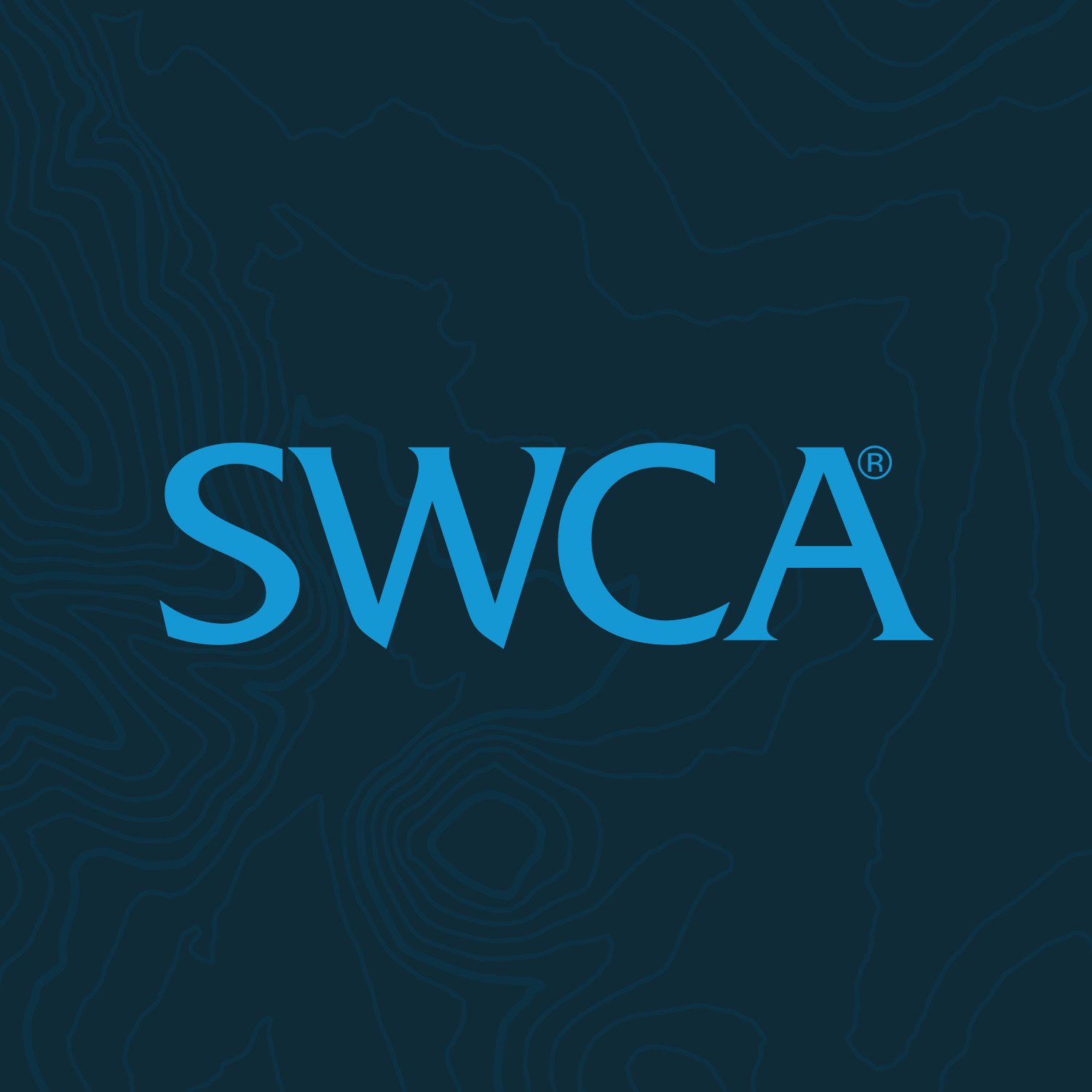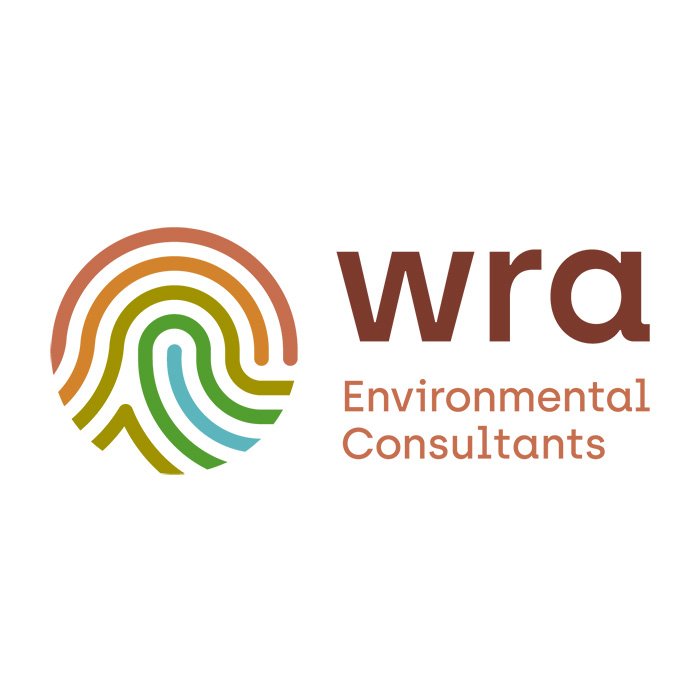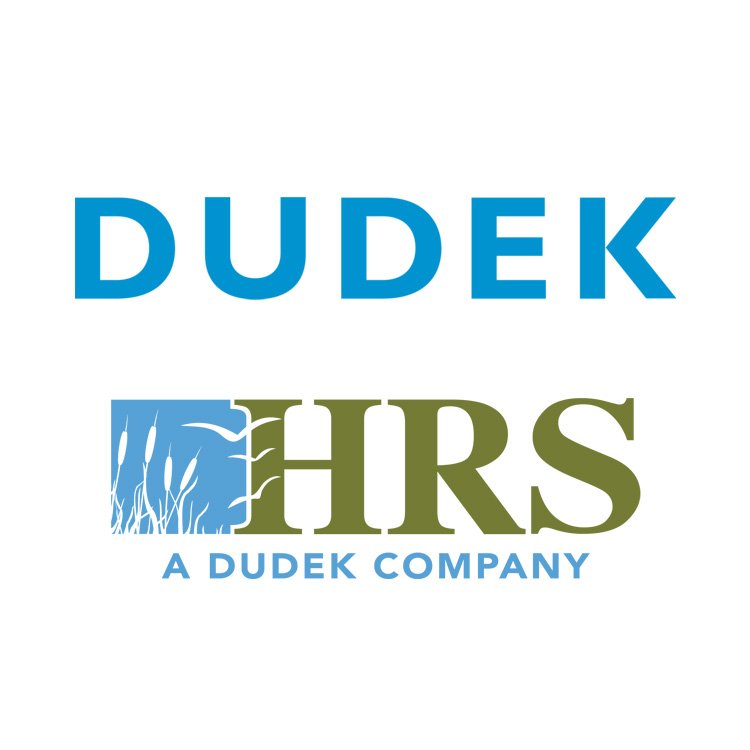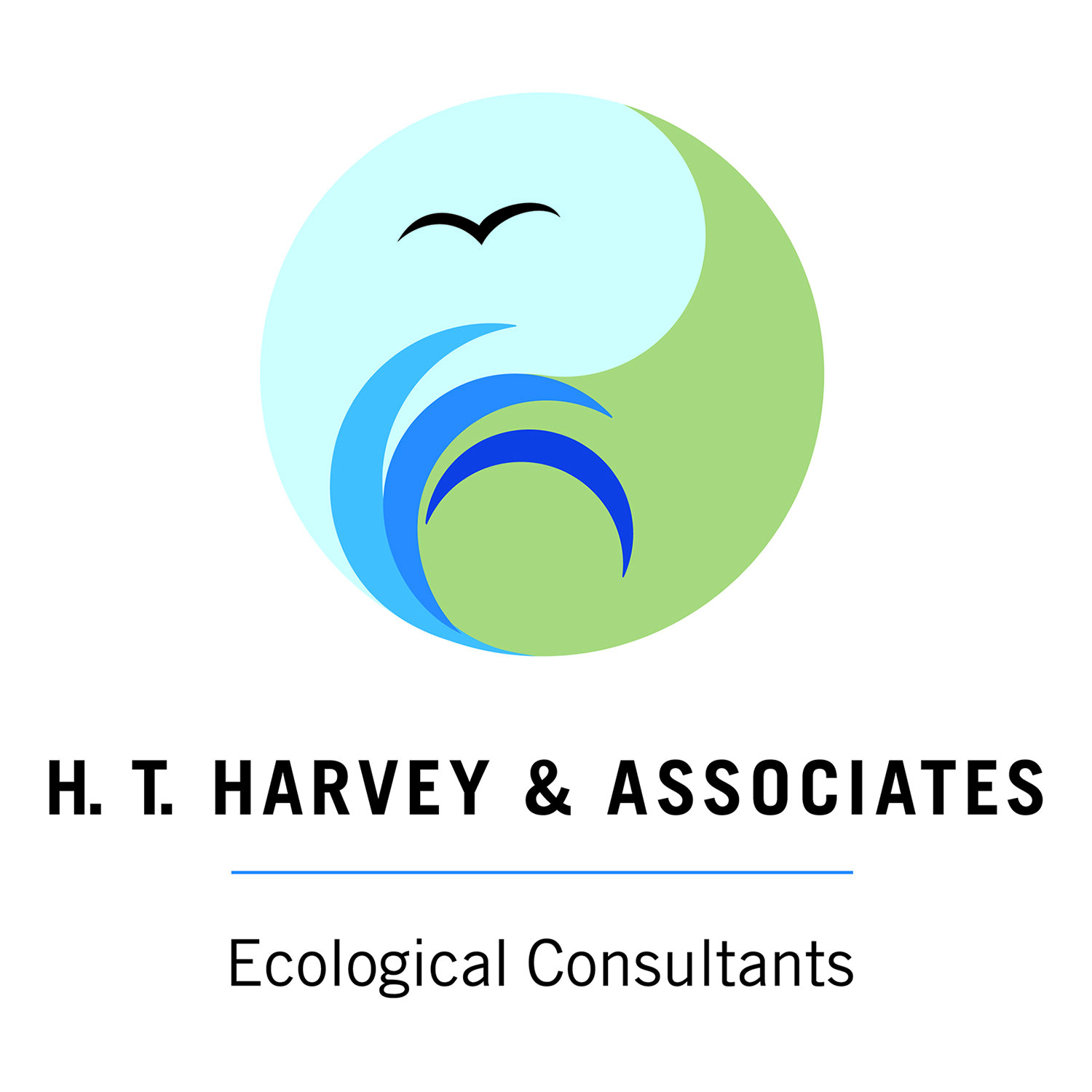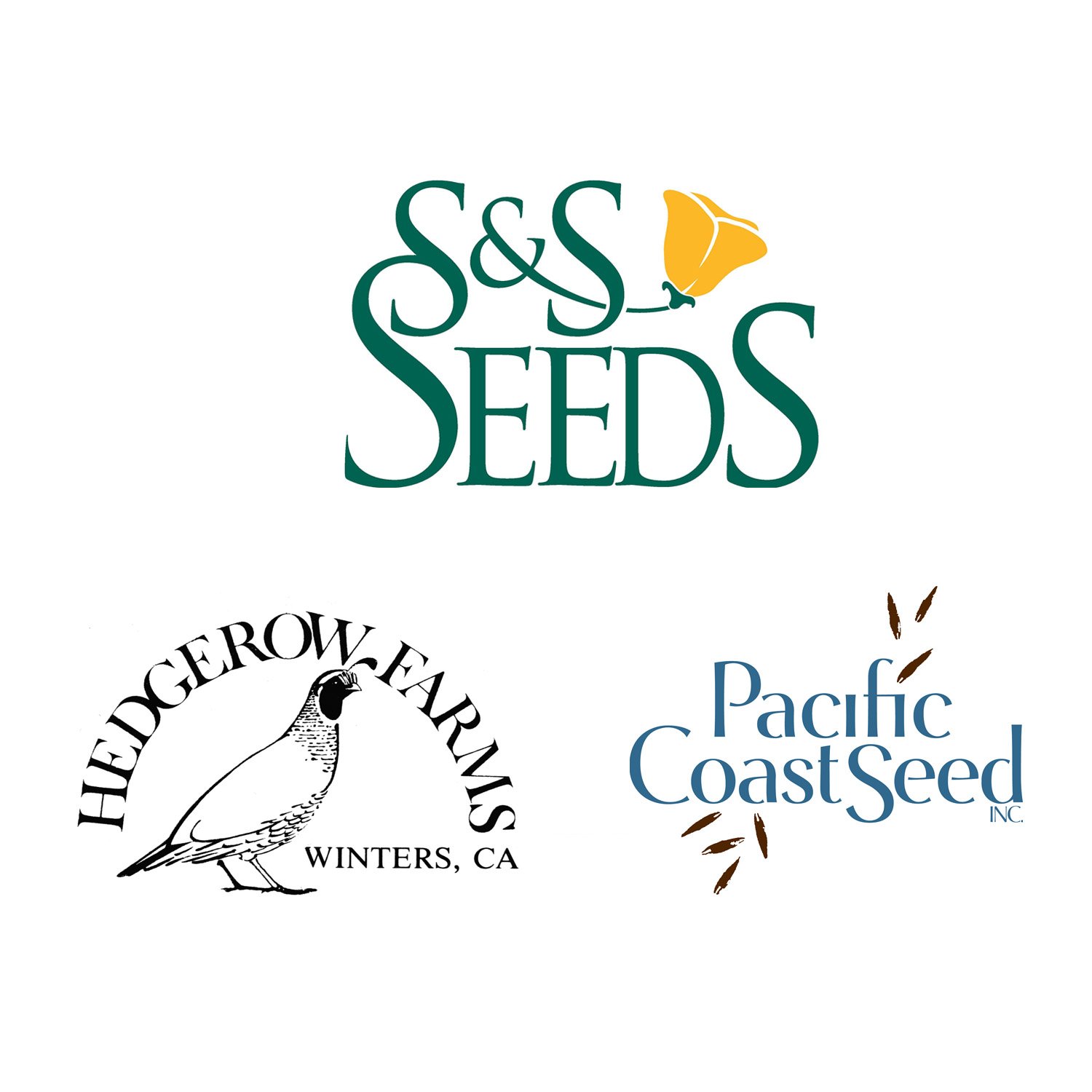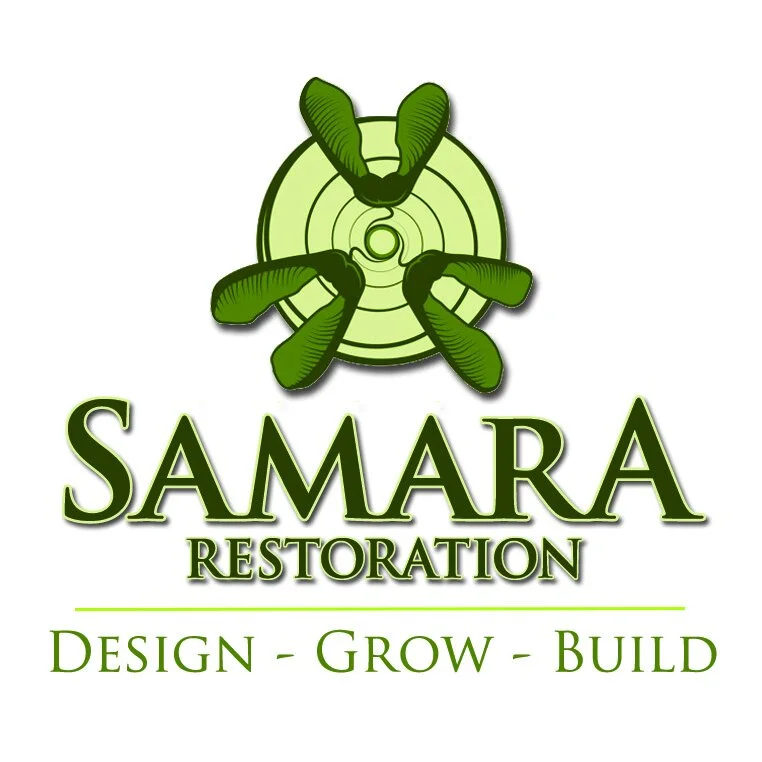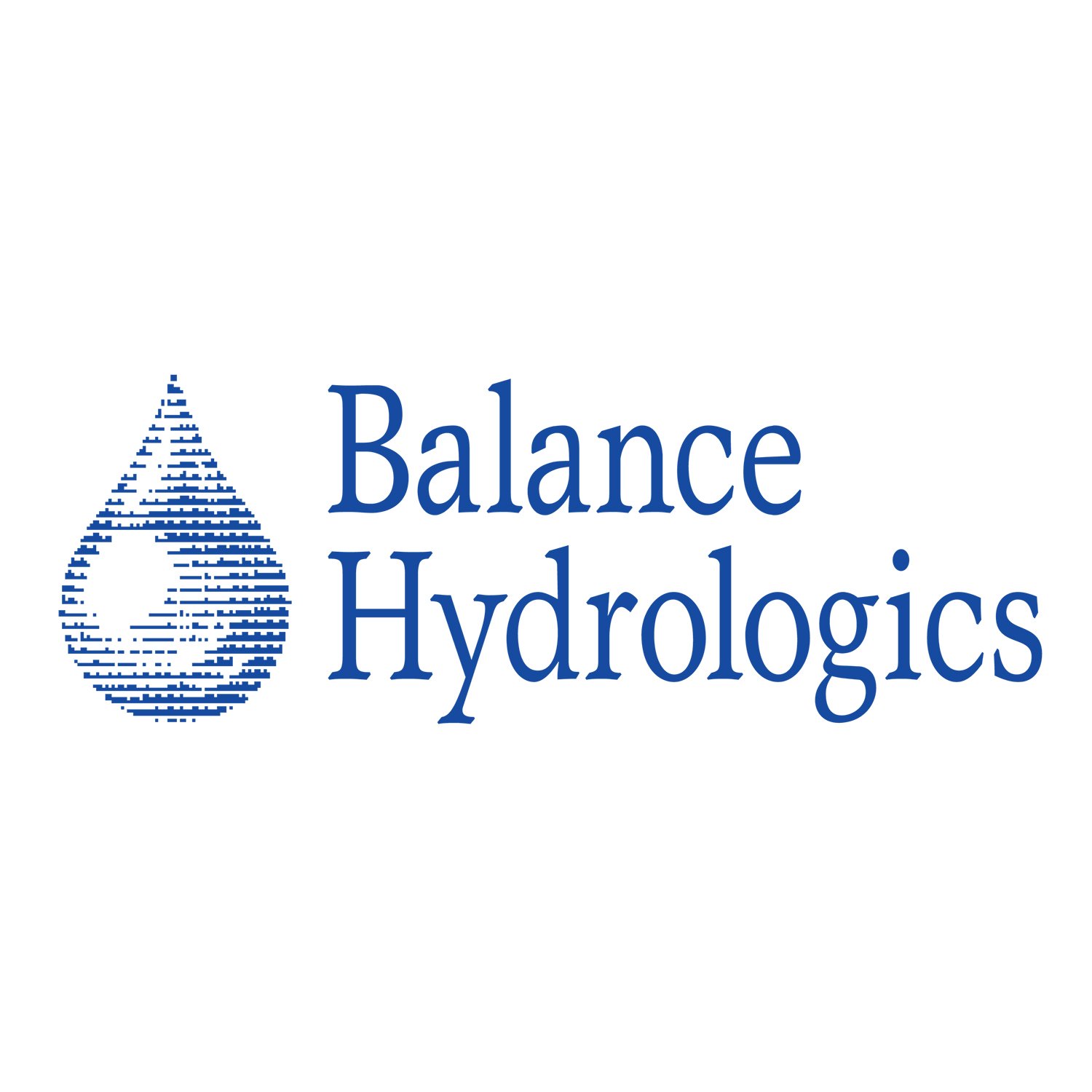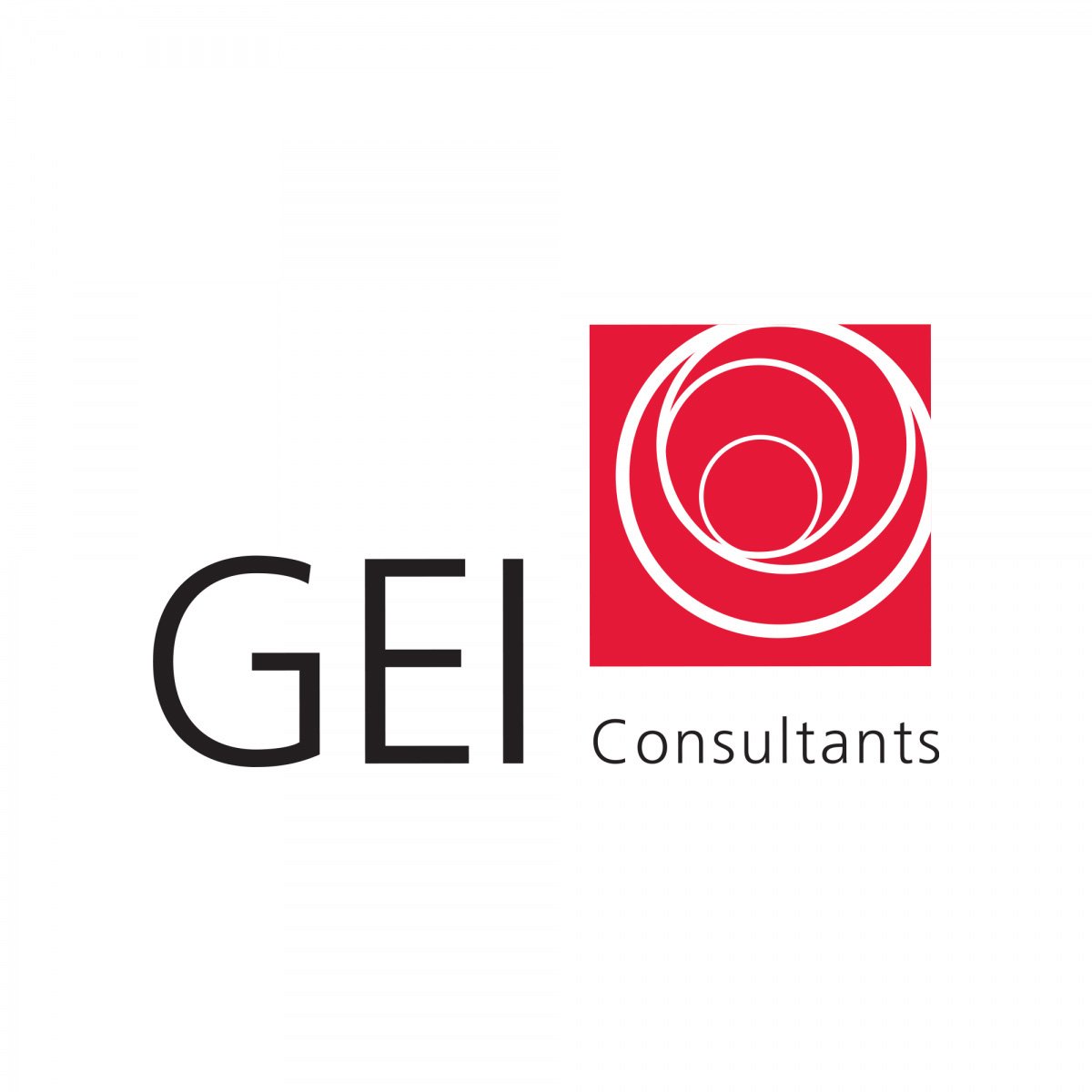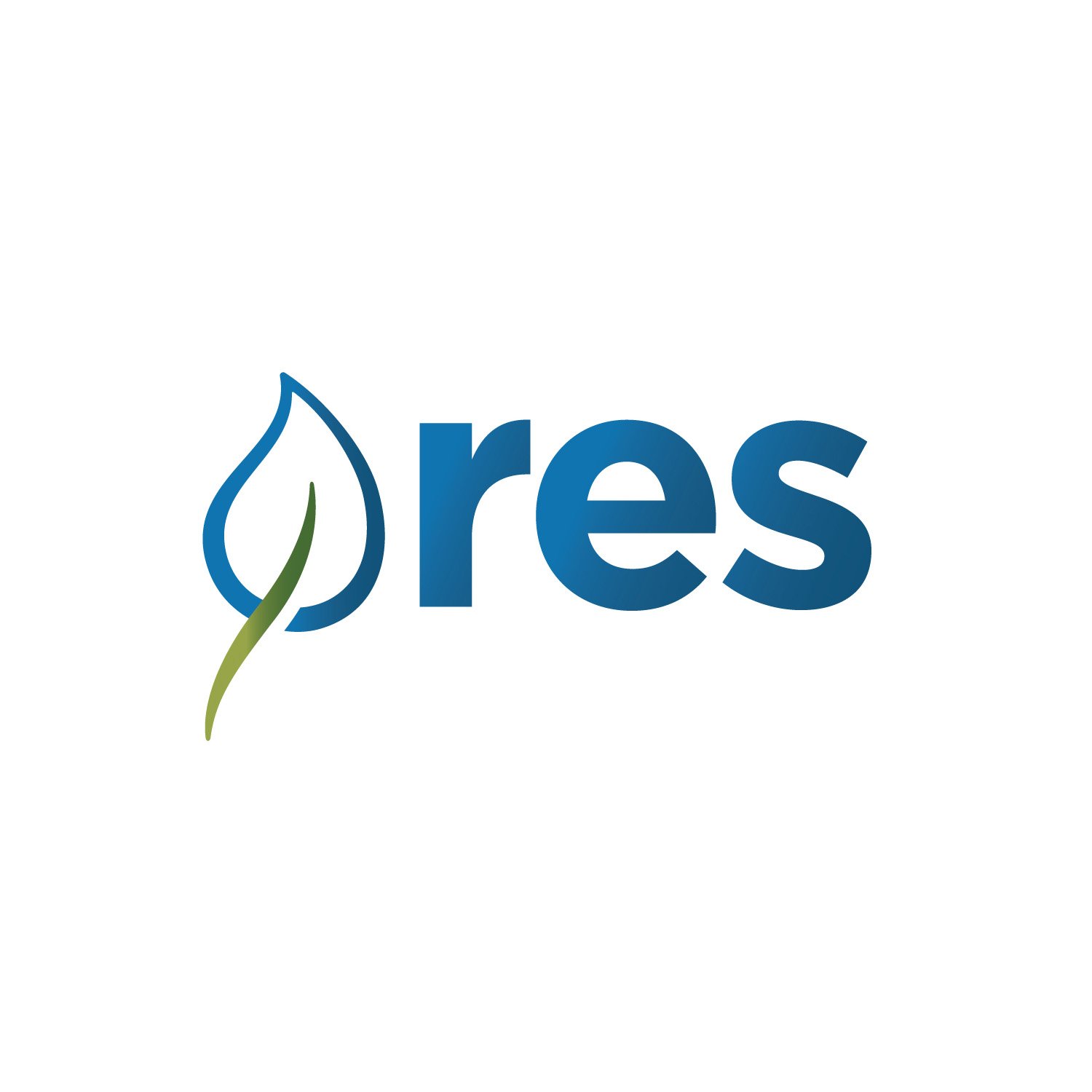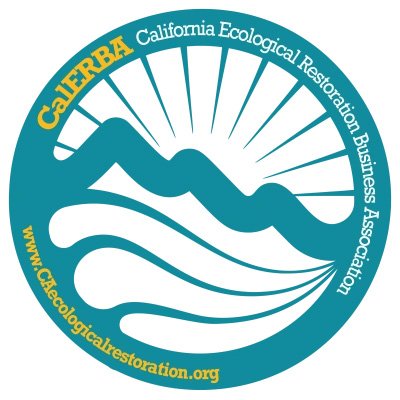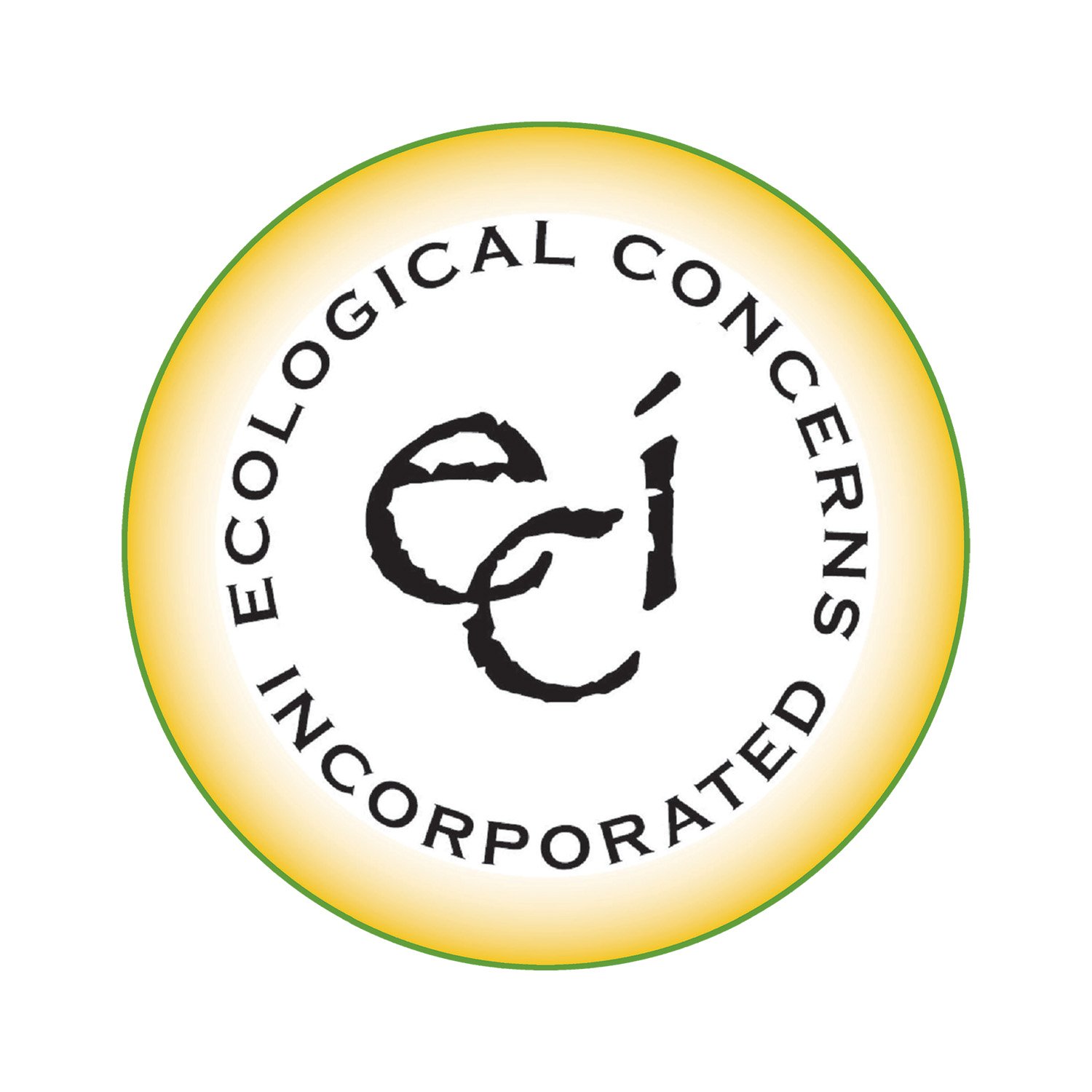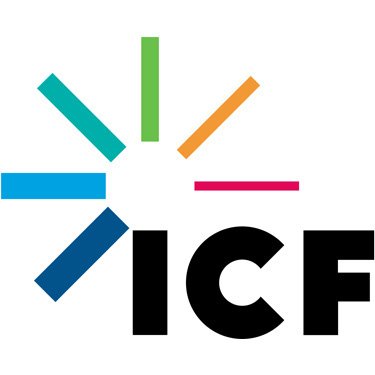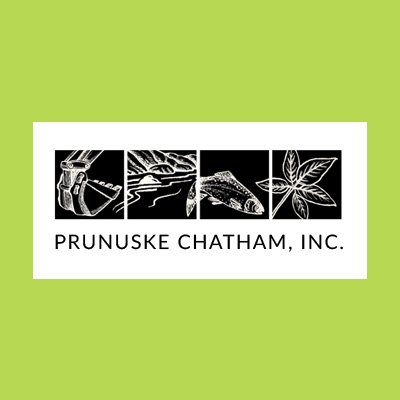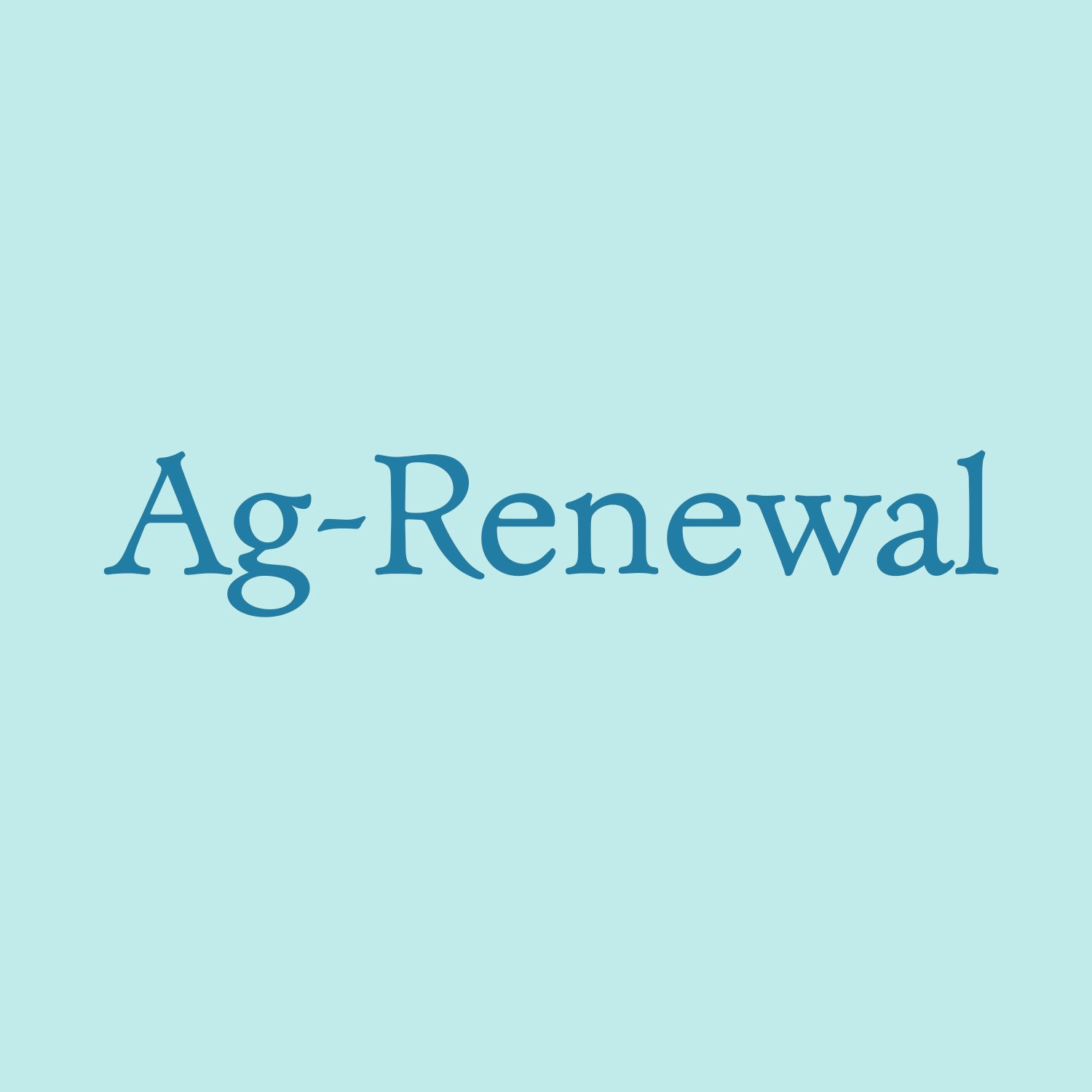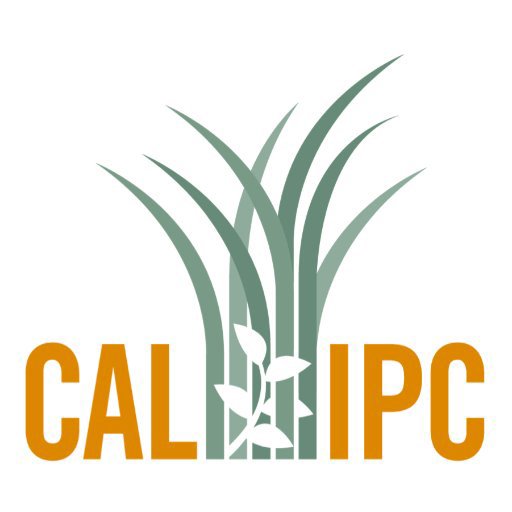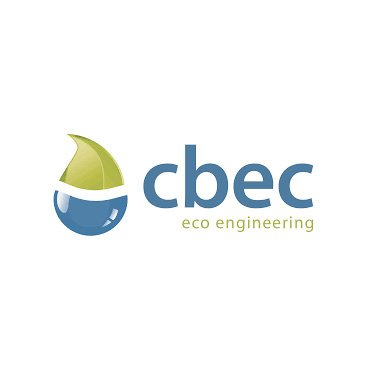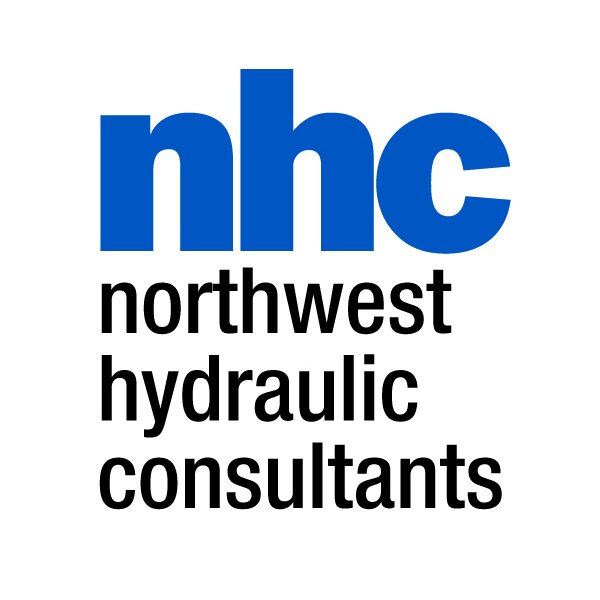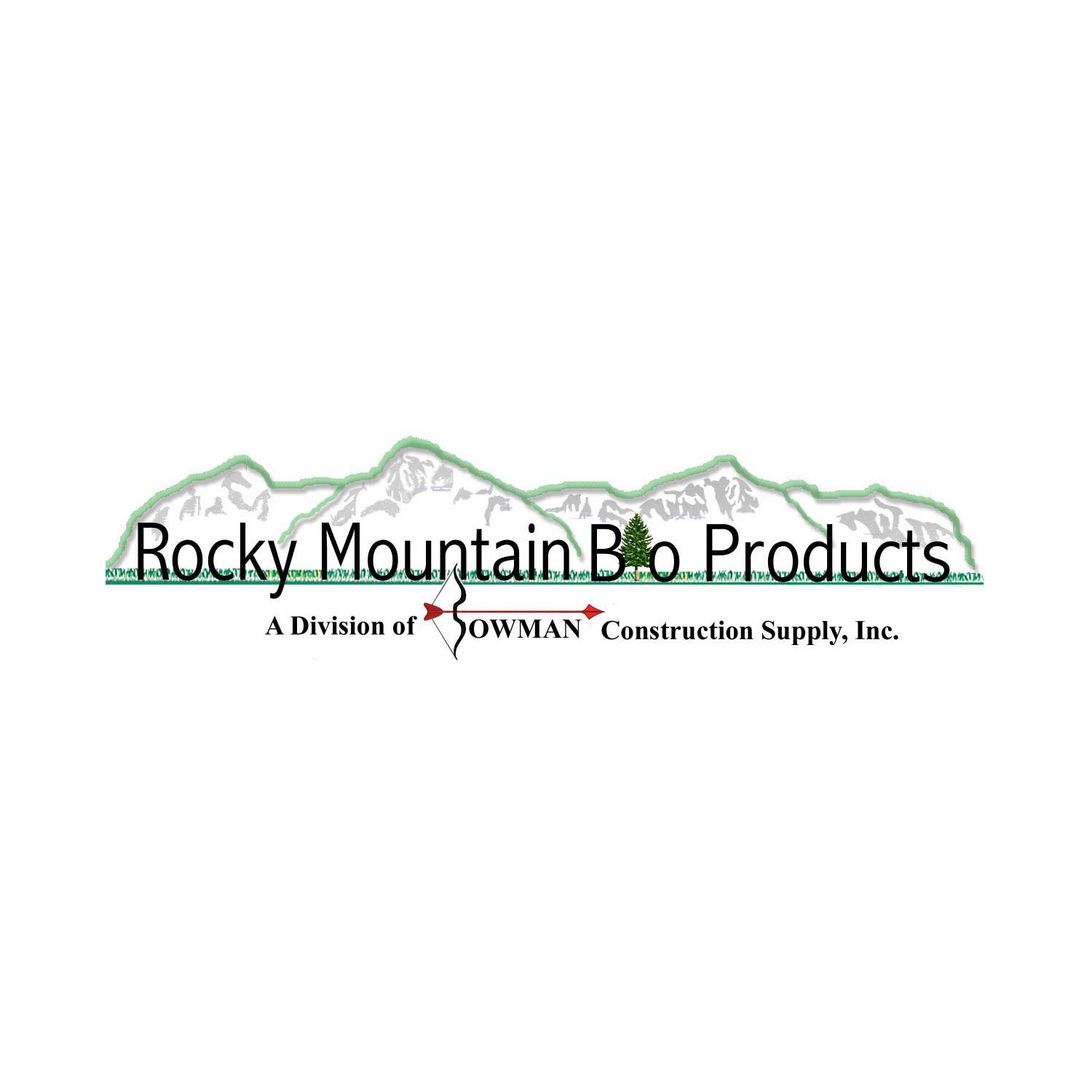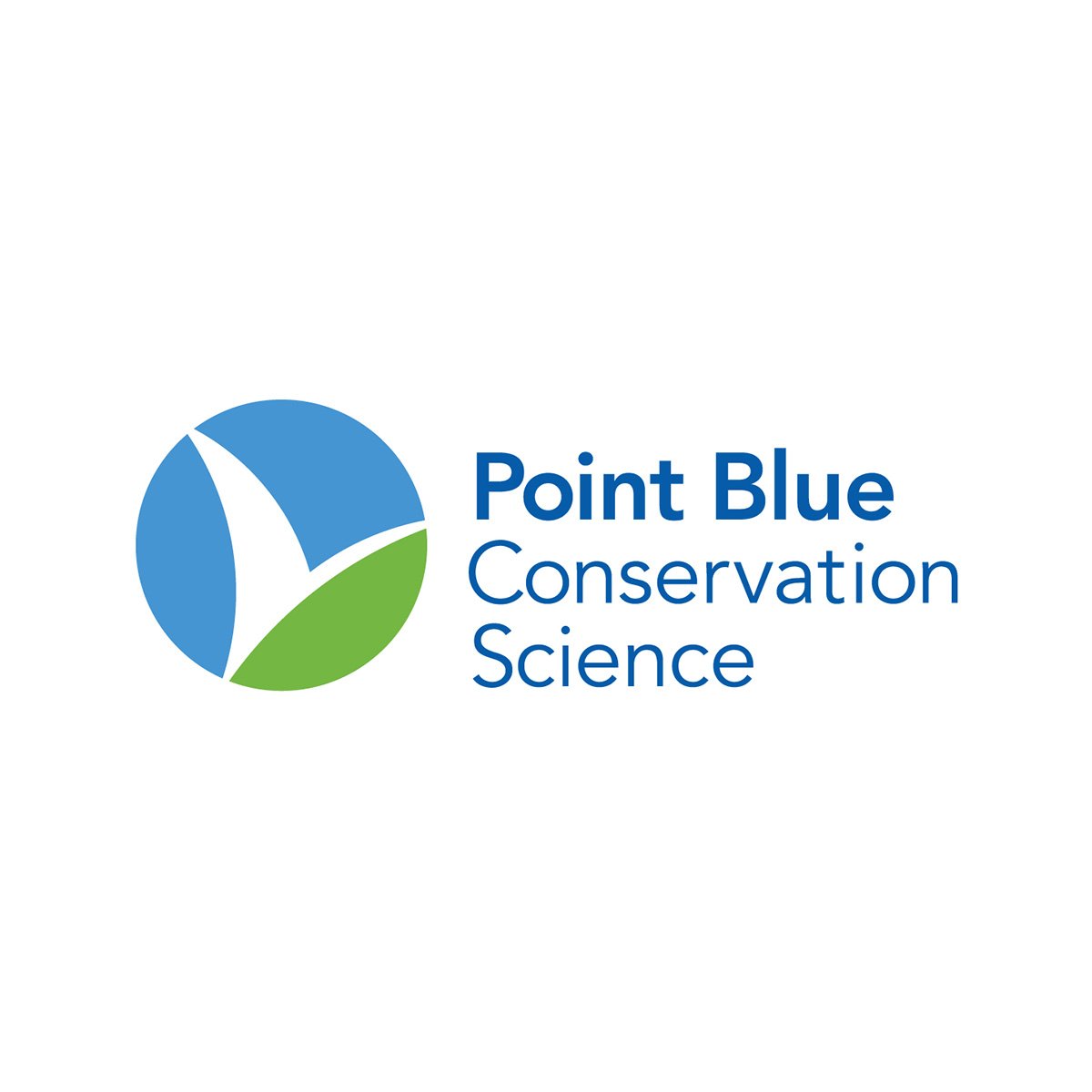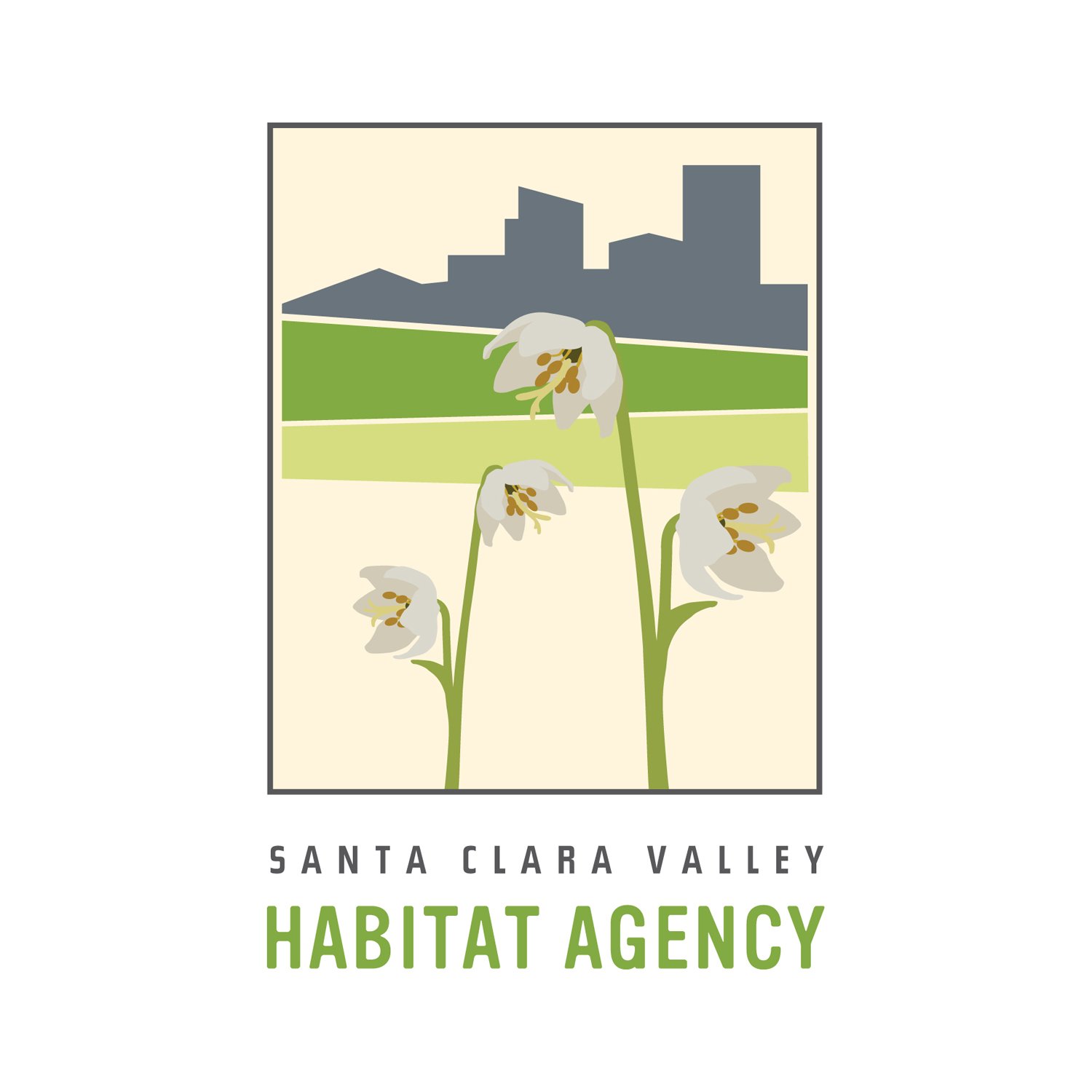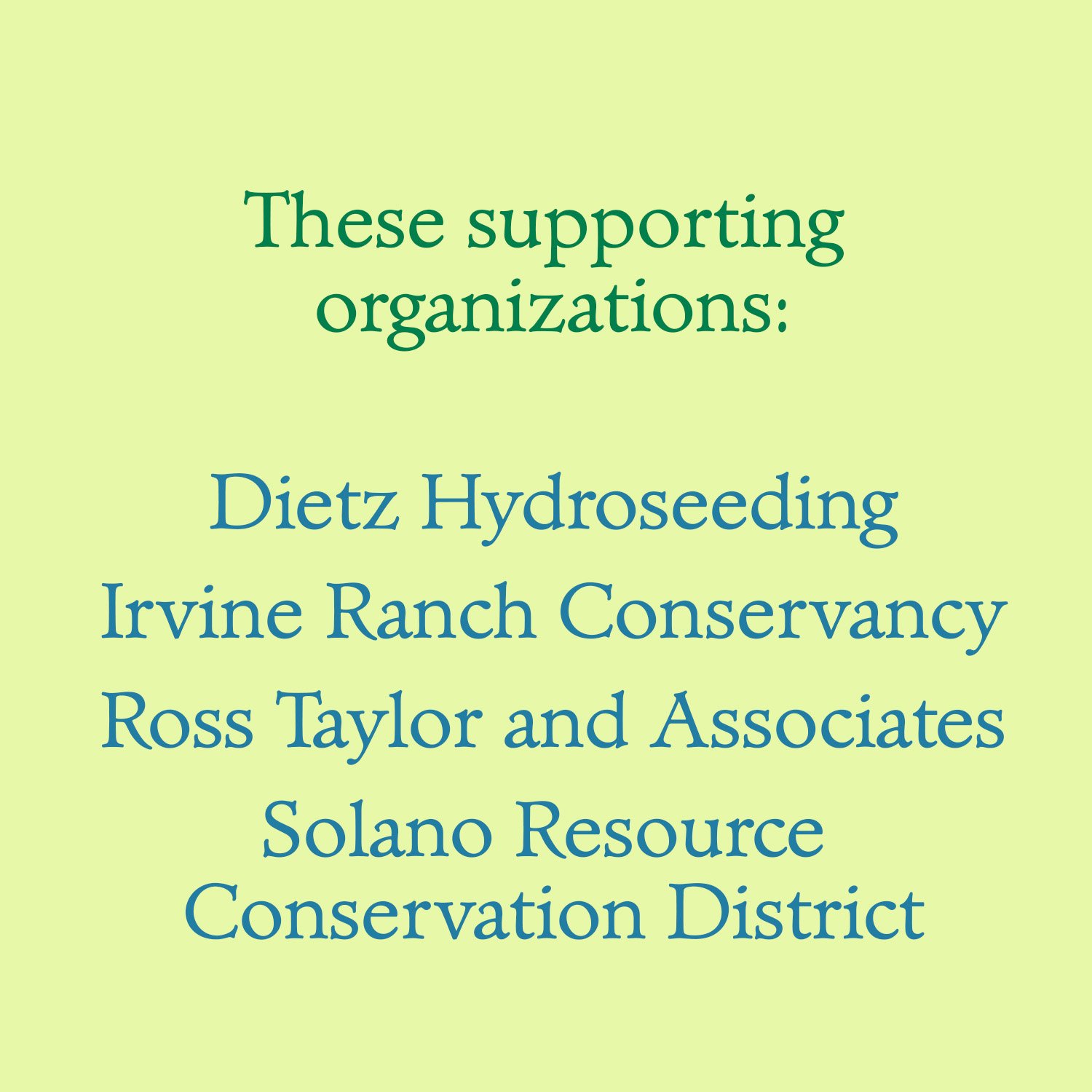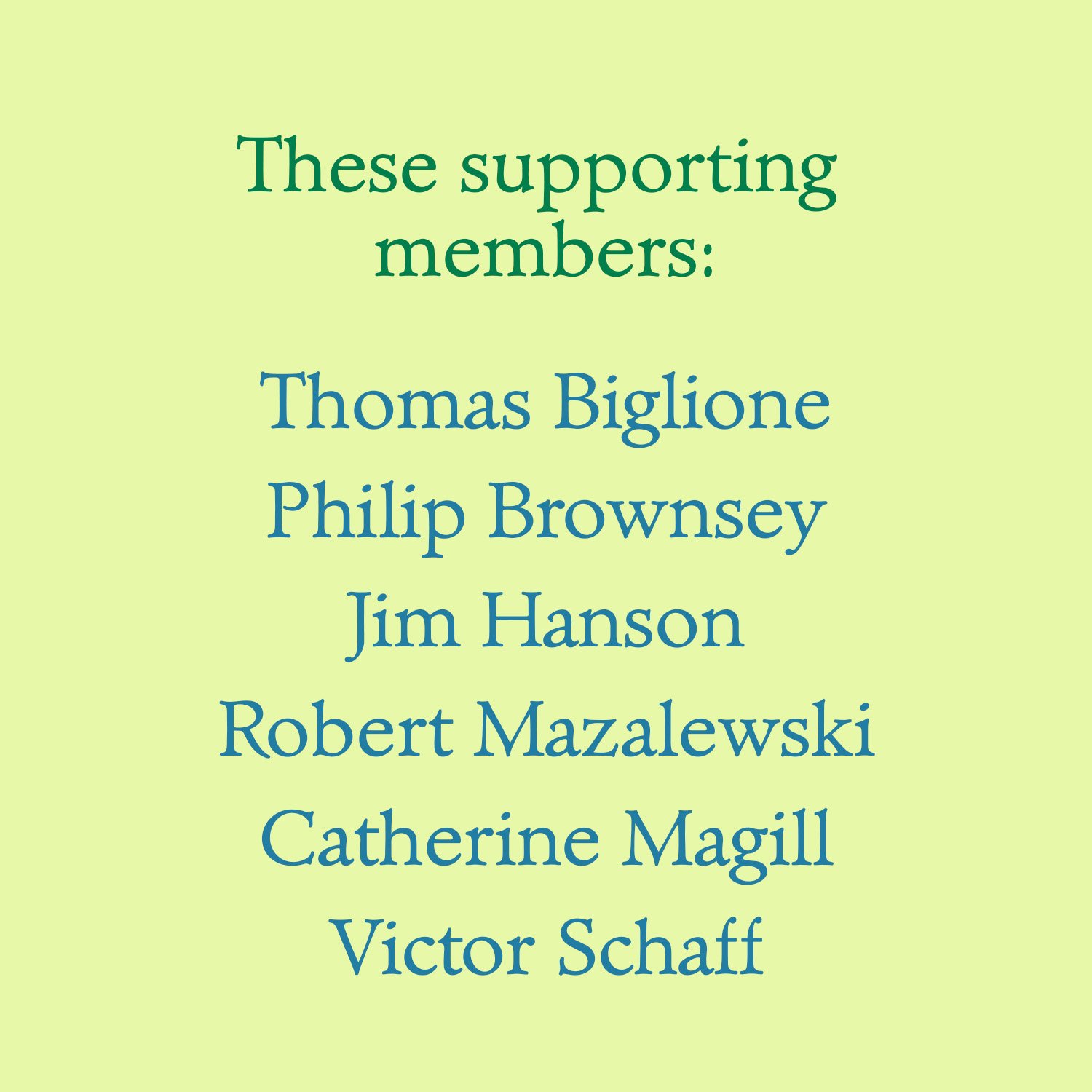Join us May 8–10 at University of Redlands in the heart of the Santa Ana River Watershed
Registration is open And you’ll be able to join or renew at the same time. We’re excited about this conference and we hope you are too!
Please note:
1) The deadline to submit your abstract for an oral presentation is due January 15. If you are presenting a poster, the deadline is March 22.
2) If you are planning to apply for a stipend, please register first! The stipend application is here.
SERCAL 2024 working themes:
Holistic Restoration: Uplands to Wetlands Restoring/Reconnecting People to Place
Urban & Community Restoration
Tribal-led Collaborations
Public Lands Partnerships
Creative Funding: Grants to Banking
Restoration of Coastal Resources
Climate Resilience Strategies
Species-Focused Restoration
Focus on: Santa Ana River
Focus on: LA River Watershed
Safeguarding Unique Habitats
Protecting Pollinators
Youth Engagement: Outreach & Education
Public Access Connectivity
Making it Work Across Borders
Monitoring at All Stages
the abstract deadline for oral presentations is january 15, 2023. the deadline for poster abstracts is march 22.
What is a SERCAL Conference?
A FEW NOTES ON RESTORATION’S FINEST ANNUAL GATHERING (AKA SERCAL CONFERENCE)
Almost every year since 1992, the California Society for Ecological Restoration has gathered people who are connected to or interested in the work of restoring California’s native habitats. This community comes from a wide variety of educational and professional backgrounds — they are biologists, ecologists, hydrologists, landscape architects, engineers, conservationists, students, academics, consultants, agency staff, and more — but for all their differences, they find inspiration and opportunities for collaboration when they meet each other and share their work.
Our 2024 Conference Co-Chairs are Lindsay Teunis (SWCA) and Sonya Vargas (ESA)!
Get exposure to the latest in technology and new ways of problem-solving
Listen to inspiring, eye-opening presentations and introduce yourself to the speakers during a break or lunch.
Attend the Poster Session, meet The Next Generation (students and emerging professionals), and learn fresh new perspectives on integrating science with practice and community engagement.
Meet new colleagues you could be working with throughout your career
With three concurrent sessions over the two days, you’re going to see who else has the same interests!
The Mentorship Program offers more than you might think — Mentees can find their next employer and Mentors can find great new recruits.
Relax and enjoy meeting like-minded, engaged, friendly people
There’s something for everyone, whether it’s the session topic, a delicious meal, or the opportunity to explore ideas in a wide-ranging or focused way.
Registration includes all hosted receptions, brunches, dinners, morning and afternoon snack buffets — there are no hidden costs! All you need is to get yourself there. We’re renting a dorm for a fun, low-cost, carbon-footprint-friendly, and car-free option to the hotels. And of course we’ll have a list of hotels offering a conference discount. And we’ll be offering some stipends to offset registration, travel, and lodging costs for students and emerging professionals from under-served communities.
Of course you’re probably going to want to set aside at least a little cash for the Raffle, featuring great items, large and small, donated by the Board and friends of SERCAL. It’s a win-win — proceeds from the Raffle go to provide waived registrations and stipends for The Next Generation.
Enjoy Highlights from SERCAL 2023 in Davis
Jump to: Explore Past Conference Themes | Meet the Creators of Conference Magic
Click on the image or presentation title for a direct link to the presentation on youtube!
José González, Latino Outdoors — Watch his keynote: Healing Severed Connections
Nailah Pope-Harden, Climate Plan — Watch her keynote: The Little Community that Could
Earyn McGee, PhD, “AfroHerper" — Watch her keynote: #FindthatLizard: Ecology, Science Outreach, and Supporting Underrepresented Groups in Herpetology and Natural Resources
Brad Henderson and Jen Olson —Watch their keynote: Cutting the Green Tape Program at CDFW
Brook M Thompson, Karuk and Yurok Tribes — Watch her keynote: A Time “Before” “American” History
Brook M. Thompson and Ivan R. Senock, moderated by Allegra Bukojemsky — Watch the panel: How to Successfully Work with Local Tribes on Restoration Projects
Congratulations to SERCAL 2023’s Student Poster Awardees!
1st PLACE: Nora Bales — Coastal Grassland Plant Community Shifts Along a Grazing Management Continuum
2ND PLACE: Alexandra von Ehrenkrook — Characterizing Red-eared Slider Upland Habitat Use at Bushy Lake in Sacramento, California
3rd PLACE: Mazy Hardell-Serrano and Kyle Foster — Testing Germination Methods for Efficacy in Mojave Desert Species
Explore Past Conference Themes…
Cultivating Connections | 2023 in Davis & Zoom
Think Big, Start Small, Restore Now: Planting Diversity in Our Projects and Communities | 2022 in Carmel Valley, Live-Streamed on Zoom, and Recorded in its Entirety
Restoration in Our Backyard | 2021 Webinar-Style Conference
Shedding Light in Challenging Times | 2020 Webinar-Style Conference
Beyond Recovery: Restoration for the Future | 2019 in Santa Barbara
In the Blink of an Eye | 2018 in San Diego
Looking Back… Leaping Forward! | 2017 in Davis
Creativity in Collaboration | 2016 in Tahoe
Restoration for the Next Generation | 2015 in San Diego
Working Collaboratively for Successful Restoration | 2014 in Santa Rosa
SERCAL's 20th Annual Conference | 2013 in Santa Barbara
A Cross-Section of Central Valley Restoration | 2012 in Davis
An Integration of People and Disciplines | 2011 in San Diego
A View of Restoration from the Range of Light | 2010 in Mammoth Lakes
A Confluence of Perspectives and Experience, a Joint Conference with CNGA | 2009 in Folsom
Restoration's Bigger Picture: Linking Local Restoration to Regional and Global Issues | 2008 in Santa Rosa
Restoration from Sea to Shining Sea | 2007 in San Diego
Shovels to Science: A Full Range of Restoration Practice in California | 2006 in Santa Barbara
Meet the Creators of Conference Magic
We’ll be introducing past, present, and future conference leaders as we interview them! Why is this important to share with you? Because we would love for you to participate more fully in the conference by presenting a paper or poster in a session, leading a fieldtrip, stepping up to chair a session — whatever feels right for you. Think about it!
An interview with Thor Anderson, member of SERCAL's Leadership Team
Thor was chair of SERCAL 2020, our in-person-turned-virtual conference, and came back in 2022 to chair our first in-person post-you-know-what, in Carmel Valley. Thank you, Thor! You are a rock star!
What is your occupation and who do you work for? Senior Ecologist and Project Manager for Harris Environmental Group, Inc.
What is the biggest benefit of working on the SERCAL conference committee/leadership team? Inspiration, networking, learning, sharing, and building community.
What are you most proud of in your restoration work? I am most proud of my restoration work at the former Fort Ord, where I have been able to help restore native oak woodlands, grasslands, vernal pools, and the rare maritime chaparral habitats for the last 25 years. I became involved in habitat restoration at the former Fort Ord when I volunteered on projects as a CSU Monterey Bay college student in the late 1990s. That volunteer work grew into an internship, which eventually evolved into a professional position with the Watershed Institute of CSUMB, where I continued to contribute to former Fort Ord restoration projects through the years. Then, in 2011, as a consultant, I had the opportunity to lead the restoration of 62 acres of maritime chaparral habitat at the former Fort Ord for the Army. My restoration work at form Fort Ord continues today as I monitor these restoration sites to ensure their success. I take great pride in this work because I've witnessed the success of the restoration over time, and I plan to continue my efforts at the former Fort Ord for many years to come.
Which (endangered) native species do you most hope to see thrive in the coming years? I would like to see the federally endangered Smith’s blue butterfly (Euphilotes enoptes smithi) thrive, which can be achieved through the acquisition and restoration of critical habitat for the species in the upcoming years.
What do you hope to see in terms of ecological restoration in the next year or so?
I am excited to witness the outcomes of California's '30x30' goal, which aims to conserve 30% of its land and coastal waters by 2030. This initiative presents a fantastic opportunity to protect, restore, and expand access to natural lands, contributing to the building of resilience against climate change. I believe '30x30' is a significant opportunity to advance ecological restoration throughout California.
An interview with Brian Bartell, member of SERCAL’s Leadership Team
Brian is an affiliate on the Board who is now running for a Board position! He has been so helpful in our Mentorship and Conference work and we are excited he is making this next step. Thank you Brian!
What is your occupation and who do you work for? I am a landscape architect specializing in wetland, floodplain and river restoration with a focus on salmonids in Northern California, working for Prunuske Chatham, Inc., (PCI).
What is the biggest benefit of working on the SERCAL conference committee/leadership team? Restoring lost habitat is my passion, and being on the SERCAL board allows me to share that passion and encourage others to thrive in the field of ecological restoration.
What are you most proud of in your restoration work? That question is hard to answer. I have a few large-scale and impactful projects that I am very proud of, but I think what I am most proud of is being involved in the evolution of the restoration field over the past 25 years. My personal journey has taken me from the early days on the east coast completing simple creek channel and wetland projects to my work in California designing and building complex habitat restoration projects including vernal pool complexes, dam removals and floodplain/side channels for salmonids. And the field itself has also evolved so much over the past few decades. The science is catching up and the benefits of our restoration efforts have increased exponentially.
Which (endangered) native species do you most hope to see thrive in the coming years? Steelhead, coho, and chinook salmon.
What do you hope to see in terms of ecological restoration in the next year or so? The largest need I see in advancing restoration in California is to get all of the regulatory agencies on board with streamlining the permitting of restoration projects. The California Department of Fish and Wildlife has spearheaded the Cutting the Green Tape effort, which has helped tremendously. But some of the other agencies continue to treat restoration work in the same manner as development projects, which results in unnecessary expense and significant time expenditures.
An interview with Joanna Tang, member of SERCAL’s Leadership Team
Joanna has been an affiliate on the Board for about two years and we are so lucky to have her energy and enthusiasm! These days she is guiding the Mentorship Program — improving and fine-tuning — and she’s also chaired sessions at the last two conference.
What is your occupation and who do you work for? I’m a PhD Candidate at UC Santa Barbara studying restoration ecology.
What is the biggest benefit of being a SERCAL affiliate? Getting a behind-the-scenes look at the amazing work SERCAL does. It’s really interesting to see how a non-profit operates and how each individual contributes to make things happen, and I find it really empowering and inspiring.
What are you most proud of in your restoration work? I am most proud of just having my hands on the land, transforming a landscape into a beautiful native community. I also love being able to do restoration work with local community members and students to empower them to steward their land. I loved working at Grassroots Ecology, bringing local school groups out for native planting days in local open spaces.
Who or what has inspired you to work in restoration? My parents inspired me to be curious about the world around me, and I grew up in the Bay Area where I could play and learn outside. Experiencing the benefits and beauty of nature inspires me to take care of it — it's a reciprocal relationship.
What do you hope to see in terms of ecological restoration in the next year or so? I hope to see more local stewardship initiatives oriented toward building resilient communities. Indigenous-led stewardship work can revive stronger relationships between people and nature and spearhead restoration work that build resilient communities of plants and people.
An interview with Mando Valencia, newest member of SERCAL’s Conference Committee
We’ll let Mando introduce himself, but we just want to say that we’re excited that he stepped up to become and affiliate after his first SERCAL conference. We know he’ll bring a lot of great ideas to SERCAL 2024!
What is your occupation and who do you work for? Currently, I am an undergraduate student at California State University, East Bay majoring in Environmental Studies. I am also a docent at Jepson Prarie Nature Preserve where I assist in guided tours over the Spring and am blessed with the opportunity to share my favorite ecosystem. Im mostly interested in how human development in practice and thought impacts ecological systems and narratives over time, and what mitigations can be implemented to restore environmental understanding in modern cultures. Currently, I work for WRA as a Project Biologist doing biological monitoring for restoration sites. It's a really interesting way to see how collaborative these efforts can be and what opportunities we have within our communities to promote this type of pre-infrastructure.
What is the biggest benefit of your SERCAL membership? I’m working on a lot of really cool projects and the idea of ecological restoration is the full-circle application of scientific research, social studies, and sustainable policies. Working with SERCAL gives me the opportunity to see other projects in action and the strategies developed to see them to completion.
What is your favorite California native species? It's hard to determine my favorite native species. Over time, I have learned to grow fond of birds and plants in ways that I had not previously considered. I am also very fond of my vernal pool mascots like CTS or fairy shrimp. However, I would like to give a shoutout to the Delhi sands flower-loving fly. I went to high school at Colton High in southern California where we could walk to the fence line that said “Do not enter this area is habitat for deli sands flower-loving fly”. If you would like more details I could elaborate. Look it up and maybe it will explain itself. :)
What do you hope to see in terms of ecological restoration in the next year or so? I am excited to see the next generation of ecologists integrate restoration work into their endeavors. With a dynamic of social justice at heart, I think that an emphasis on meaningful results is impactful in creating a driving narrative of the potential for sustainable and ecological transformation.
An interview with Ashley Zavagno, Co-Chair of SERCAL 2023 — Cultivating Connections
Ashley is Senior Restoration Ecologist at WRA, Inc. She co-chaired the conference with Isaiah Thalmayer, and we’ll include his interview soon!
How was your experience being the co-chair of the last SERCAL conference? Being the co-chair of the last SERCAL conference was a lot of fun and a great learning experience for me. I really enjoyed developing the conference theme, reviewing the abstracts, and collaborating some of the other SERCAL board members to plan the event. In terms of a learning experience, I quickly realized how difficult a hybrid event is to successfully pull off, especially if you don't have dedicated IT experts at your disposal. There are things I would do differently, but I am still proud of the event we put together. I also learned a lot about what topics and speakers people found engaging and what things people would like to see change. It is always exciting for me to see what resonates with others. I have learned a lot and made a lot of great connections at past SERCAL conferences, and so it was gratifying to be able to contribute to SERCAL in this way.
How has your perspective changed since the conference? I am not sure this conference necessarily changed my perspective in any particular way, but it did reaffirm for me the importance of people getting together in person to share ideas, network, and strengthen existing relationships. Many SERCAL members have expressed that this is one of the main benefits of being a member. In this digital age, there will always be a balancing act between the need for face-to-face connection and the need for accessibility to a broad and diverse audience. I would love to see SERCAL continue to focus on providing resources to help more students and other members that may have limitations attend conferences and other events in person. I think this could be through financial means, but also decisions such as the location and timing of the conference and other events.
What are you most proud of in your restoration work? I am most proud of incorporating process-based restoration design approaches into my restoration projects. I believe focusing on restoring ecological processes rather than particular habitat forms will lead to better long-term outcomes and more, resilient and sustainable habitats. My hope is that I can learn from my existing projects and incorporate lessons learned into my future projects to make them even more successful. I am a lifelong student and always interested in evaluating new approaches and research to see how it can be applied. It is also very personally rewarding when you see wildlife returning to a site you restored as they are in some ways the ultimate judges of the success of the work.
What do you hope to see in terms of ecological restoration in the next year or so? I really hope to see Cutting the Green Tape initiatives advance more quickly so that restoration practitioners can implement projects at the pace and scale needed to address the ecological problems we are facing. With challenges such as increasing habitat loss, increasing water demands, and the effects from climate change including wildfire and flooding risk, sea level rise, and more frequent and extreme droughts, we don't have years and decades to wait. I would also like to see an increased focus on holistic ecosystem restoration that isn't just focused on one particular species or habitat of interest. Addressing the impairments and constraints on an entire ecosystem or watershed whenever possible I think will better ensure our restoration projects are self-sustaining and deliver the full suite of ecosystem services. We also need to consider the use of all the tools in our restoration toolbox to make meaningful progress to reverse the decades of ecological damage we see on our landscapes. Approaches such as assisted migration have been controversial in the restoration community and I think the debate about the risks and benefits are meaningful and important. I think it is equally important; however, to consider that inaction has a real ecological cost as well.
